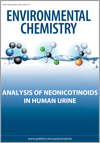EN18202Assessment of labilities of metal complexes with the dynamic ion exchange technique
Environmental context. In natural waters, the impact of metals on biota is modulated by their binding with ligands. Ion-exchange techniques can provide information about metal-ligand complexes in solution, which can be linked to metal bioavailability in natural waters. We investigate modelling approaches to interpreting data from ion-exchange experiments to help elucidate the contribution of a particular complex to the overall metal uptake.





